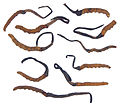Core lobe
The division of living beings into systematics is a continuous subject of research. Different systematic classifications exist side by side and one after the other. The taxon treated here has become obsolete due to new research or is not part of the group systematics presented in the German-language Wikipedia.
Some parasitic fungi are summarized under the vague term core lobes . They belong to the Ascomycetes (hose fungi). Originally all of these species were grouped in the genus Cordyceps (Fam. Cordycipitaceae , previously Clavitipitaceae). In the meantime, many core lobes have been relocated to two new genera that belong to a different family, the Ophiocordycipitaceae (see below), so the “core lobe” could not be kept as a taxon. Most species are rarely found in Central Europe.
features
The fungi parasitize deer truffles ( Elaphomyces ), in rare cases, root truffles ( Rhizopogon ) or insects or spiders . The fruiting bodies (stromata) consist of a stem and a fertile head in which the perithecia are located. The former is usually longer than the depth under the earth's surface in which the host lies. In the asci there are eight long thread-like and septate spores; the septa arise when the spores mature. Its distance is of great importance for the determination, but measuring spores that are still in the asci can lead to errors.
Many core lobes, like numerous other Ascomycetes, occur in a secondary crop form ( anamorphic ). These were often described under a different name than the main fruit forms ( teleomorphs ). Establishing the relationship between the two manifestations is usually difficult, as they do not look similar to each other and rarely appear together.
Pupa core club ( Cordyceps militaris ) on the pupa of a butterfly
Bumpy core leg ( Cordyceps tuberculata ) on a moth
Cordyceps ignota on a tarantula; molecular genetic analyzes are still pending.
Headed core leg ( Elaphocordyceps capitata ) on deer truffle ( Elaphomyces )
Elaphocordyceps rouxii on warty deer truffle ( Elaphomyces granulatus )
Tongue core club ( Elaphocordyceps ophioglossoides ) on deer truffle ( Elaphomyces )
Chinese caterpillar fungus ( Ophiocordyceps sinensis )
ecology
The ripe spores of the mushrooms float in the air, from where the hosts are infected. It is assumed that the spore will be stimulated to germinate once it has come into contact with the correct host. There the fungus then spreads, killing the host within a few days. Insects are then completely permeated by the mycelium and appear to be mummified . The mushroom then forms its fruiting body when conditions are favorable.
The core club species that parasitize in truffles have not specialized in any particular type of truffle. The species that grow in insects and spiders, on the other hand, are very loyal. They are rarely found on animals other than typical.
Systematics
Over 400 species have been described worldwide, the majority of which parasitize insects and spiders and are known from the tropics and Asia. About 20 species are given for Western Europe. The following list offers a selection.
- family Cordycipitaceae
- Needle core club - Cordyceps bifusispora O.E. Eriksson 1982
- Cordyceps memorabilis (Cesati 1861) Saccardo 1878
- Puppet core club - Cordyceps militaris (Linnaeus 1753: Fries 1823) Link 1833
- Bumpy core club - Cordyceps tuberculata (Lebert 1858) Maire 1917
- Family Ophiocordycipitaceae
- Headed core club - Elaphocordyceps capitata (Holmskjold 1790: Fries 1823) GH Sung, JM Sung, Hywel-Jones & Spatafora 2007
- Elaphocordyceps intermedia (S. Imai 1934) GH Sung, JM Sung, Hywel-Jones & Spatafora 2007
- Elaphocordyceps japonica (Lloyd 1920) GH Sung, JM Sung, Hywel-Jones & Spatafora 2007
- Longspore or Canadian core lobe - Elaphocordyceps longisegmentis ( Ginns 1988) GH Sung, JM Sung, Hywel-Jones & Spatafora 2007
- Tongue core lobe - Elaphocordyceps ophioglossoides (Ehrhart 1788: Fries 1823) GH Sung, JM Sung, Hywel-Jones & Spatafora 2007
- Elaphocordyceps rouxii (Candoussau 1976) GH Sung, JM Sung, Hywel-Jones & Spatafora 2007
- Ophiocordyceps clavulata (Schweinitz 1832) Petch 1933
- Beetle larvae core club - Ophiocordyceps entomorrhiza (Dickson 1785: Fries 1823) GH Sung, JM Sung, Hywel-Jones & Spatafora 2007
- Fly core club - Ophiocordyceps forquignonii (Quélet 1887) GH Sung, JM Sung, Hywel-Jones & Spatafora 2007
- Caterpillar core lobe - Ophiocordyceps gracilis (Greville 1824) GH Sung, JM Sung, Hywel-Jones & Spatafora 2007
- Collaret core lobe - Ophiocordyceps larvicola (Quélet 1878) Van Vooren 2009
- American core club - Ophiocordyceps michiganensis (Mains 1934) GH Sung, JM Sung, Hywel-Jones & Spatafora 2007
- Ophiocordyceps nutans - (Patouillard) GH Sung, JM Sung, Hywel-Jones & Spatafora
- Ant core club - Ophiocordyceps myrmecophila (Cesati 1846) GH Sung, JM Sung, Hywel-Jones & Spatafora 2007
- Ophiocordyceps oxycephala - (Penzig & Saccardo) GH Sung, JM Sung, Hywel-Jones & Spatafora
- Chinese caterpillar fungus - Ophiocordyceps sinensis (Berkeley) GH Sung, JM Sung, Hywel-Jones & Spatafora 2007
- Wasp core club - Ophiocordyceps sphecocephala (Klotzsch 1843) GH Sung, JM Sung, Hywel-Jones & Spatafora 2007
- Ophiocordyceps stylophora (Berkeley & Broome 1857) GH Sung, JM Sung, Hywel-Jones & Spatafora 2007
- Ophiocordyceps unilateralis (Tulasne & C. Tulasne 1865) Petch 1931
swell
Individual evidence
- ↑ a b Sung, Gi-Ho, Hywel-Jones, Nigel L., Sung, Jae-Mo, Luangsa-ard, J. Jennifer, Shrestha, Bhushan, Spatafora, Joseph W .: Phylogenetic classification of Cordyceps and the clavicipitaceous fungi In : Stud Mycol 2007 57: 5-59, Paper Online
- ^ Daniela Albat: Externally controlled : Useful means of transport , dossier article on scinexx from April 26, 2019
Web links
- Daniel Ghyselinck: Les Cordyceps de Belgique
- Core club infected ant on YouTube (accessed May 31, 2012)









